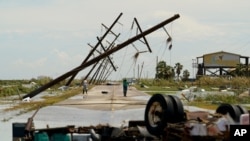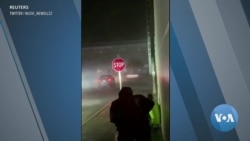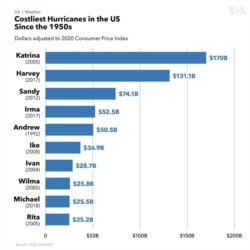As a shell-shocked Gulf Coast region began to assess the damage from Hurricane Laura, the downgraded Category 4 storm bolted north out of Louisiana Thursday, leaving in its wake snapped tree trunks, leveled neighborhoods, shattered buildings and more than 875,000 people without power.
Winds above 240 kph barreled off the Gulf of Mexico into the 80,000-person city of Lake Charles, making it the most powerful hurricane to hit Louisiana since 1856.
And while the hurricane proved less lethal and destructive than state and local officials at first feared Wednesday evening, a video posted on the internet showed the storm knocking a full-size RV on its side.
First responders reported winds peeling the roof off the casino they were being staged in overnight. Trees were thrown into homes and blocked major roads, and a riverboat that became unmoored was pushed into the supports holding up an interstate freeway.
The historic hurricane killed at least six people, according to the Associated Press, following warnings from authorities in Texas and Louisiana of “unsurvivable” flooding and catastrophic winds.
Louisiana Gov. John Bel Edwards said, “It is clear that we did not sustain and suffer the absolute, catastrophic damage that we thought was likely.”
Louisiana is likely to continue to see tropical storm-level wind and rain throughout Friday. But as residents and first responders began surveying the damage early Thursday afternoon, it was clear that many Louisianians will require months if not longer to rebuild from the impact of this storm.
"We haven't seen this kind of crisis before," said Todd Terrell, founder and president of United Cajun Navy, a Louisiana-based group of volunteers who assist in the aftermath of disasters around the United States.
Terrell explained to VOA that a convergence of preexisting conditions — including a damaged economy, tense race relations, and a global coronavirus pandemic — are making the early response to Laura's damage especially challenging.
COVID-19 makes everything different
Terrell said COVID-19, in particular, has made a difficult situation even worse.
"It's not just a matter of worrying if the person you're rescuing on your small boat has a virus," he said. "But it's also about making sure people are spaced apart when we're giving them supplies or food. Most importantly for us, though, our volunteer numbers are a lot lower than we're used to."
When Hurricane Florence hit North and South Carolina in 2018, the United Cajun Navy counted more than 1,000 volunteers in the first two days after the storm. In contrast, as of Thursday afternoon, Terrell estimated there were between 150 and 200 taking part in rescue efforts in southwestern Louisiana.
The reason, he explained, is that a lot of his volunteers are connected to the military.
"They either can't be around big groups because the military won't let them, or they're retired and older, so it’s not safe for them during a pandemic. No matter the reason, though, we need more volunteers fast."
The first day
Another thing making the aftermath of Hurricane Laura different from other recent storms is that it appears much of the destruction to heavily populated areas is a result of wind instead of water damage.
"United Cajun Navy is kind of known for using boats to rescue people during disasters, but they're not quite as important this time around,” Terrell explained. “Day One has been about finding people who are missing and getting supplies to those who need them."
United Cajun Navy sent 125,000 pounds of supplies on the first day — mostly snacks and water — but also items like diapers.
"When you come back and find your house is destroyed, those are the kind of supplies you need right away," said Terrell, who expects more residents will return to survey the damage over the weekend.
That's the plan for Victor Daigle, who decided with his family to evacuate from their home in Westlake, which borders Lake Charles, and go to his grandmother's home outside of the storm's path.
As of late Wednesday, they thought they would stay put.
"You see so many hurricanes and tropical storms that don't do anything. We figured we were OK to stay," Daigle explained. "But then when it strengthened to a Category 4 — we've got two kids, so, it was time to go."
The things that matter
One of those children, Ellis, is less than a month old. He was born premature and was released from the hospital less than a week ago.
"My wife and I are eager to see the damage to our home," Daigle admitted, "but we've seen pictures of Lake Charles and Westlake, and I don't think it's safe to drive around at the moment. There are trees everywhere."
Many of the roads are littered with fallen trees and other debris. A large stretch of the interstate has been shut down because of a hurricane-caused chemical fire at a nearby plant. The fire prompted the governor to advise all residents to shelter in place with doors and windows closed.
This is not possible for many residents of southwest Louisiana, including Daigle and his family.
"Most people who evacuated know at least one person who was crazy and decided to stay," he said. "So, it's pretty common for people to go send a text or go online and say, 'Hey, can you check out my place and make sure everything's OK?'"
Daigle said his friend sent him a picture that showed two large uprooted trees in his front yard, and a large pine tree that had fallen on top of his house.
"Yeah, that kind of got me when I saw that picture," he said.
The Daigles moved into the home two years ago. Victor, a carpenter, has been doing most of the renovations on his own.
"We finally got it looking beautiful, and now there's a tree laying across the roof," he said. "Who knows what kind of damage that's caused to our house and how long it's going to take to fix."
But Daigle said when he and his wife stopped to talk about it, it's easy to see how lucky they are.
“No matter what's wrong with the roof, or the house, or whatever — that can be fixed," he said. "My family's still with me, and that's the only thing that matters. Everything that's important is still here."












